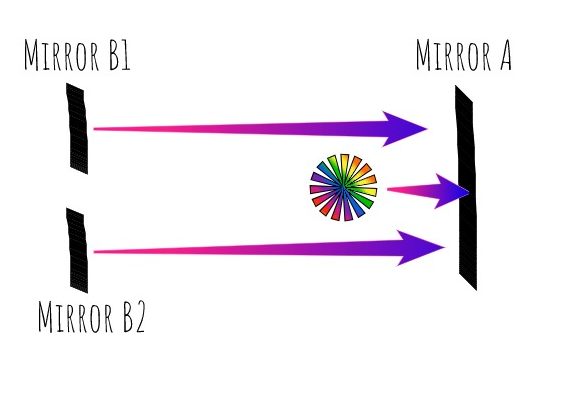This is kinda a followup question to my earlier question about magical mirrors: Magical internet - unique addressing system
Two months ago, I discovered an ancient house in the middle of woods. As I scrolled through the books stored there, I realized that it belonged to a medieval witch who called herself Baba Yaga.
Among all her possessions, I also found two Mirrors. One was called Baba Yaga's Beauty Queen and the other was called Merlin's Happy Giant.
I found out that I can connect these two mirrors at instant, providing clear vision and sound from one mirror to another.
I also tested the distance of connection: I put these mirrors 1500 km apart and I had a clear connection. Also during this test I found out, that the "signal" seems to be following laws of physics, so the speed of transferring an image is the same as speed of light.
Moreover, amongst Baba Yaga's books, I found a "Magical Mirror Maker Manual" and I was able to follow and with the usual tools and chemistry accessible to nowadays's average citizen, I was able to make a third magical mirror, which I called Pavel's Wonder.
Again, I could connect this newly created mirror to any already existing mirror.
Is there a way to make money in today's world by selling magical mirrors which can provide sound and vision connection to each other?
Things to consider:
- Mirrors can provide only one-to-one connection, while the iPhone in my pocket can do FaceTime with up to 32 people. (And my computer can connect me with any number of people I wish) EDIT, I made huge mistake here! In the linked question, I kinda hinted, that one-to-many connections are possible. Because this question is live for certain time, you can assume both (only one-to-one connection possible) or one-to-many connection is possible
- Mirrors can only transmit sound and vision. They do not have any other "apps" as my iPhone already has.
- Mirrors cannot take photos and/or selfies, neither can they store them in clouds or Facebook/Instagram
- Speaking of which, mirrors cannot connect to the internet.
- Yes, the connection between mirrors seems to be free and not requiring any signal from a tower and/or satellite. But I do not see any way how to make money on that.
- Creating a mirror can be fully automated, using generally accessible chemics.
- Creating first mirror by hand costed me about 50 US dollars in materials and two hours of my time. I tried creating another mirror, where I slashed the costs down to 35 USD and one hour of my time. Considering how I still did everything by hand, I can mass-produce a mirror in a matter of minutes for less than 10 USD manufacturing cost per pocket-size mirror.
- I have no idea how the connection itself works. And I will care only if it brings me any money
- Mirrors do not require any source of internal and/or external power to operate. But again, I have no idea how to monetize on this fact
- The magical mirror acts as a usual mirror handling-wise. It can be broken and even if only small pieces are missing from the original mirror, you cannot make any connection to such mirror.
- You can connect to any mirror if you know its identifier. Which means, every mirror has to have unique name. In the olden days it was done by naming the mirror by a magician and then including specific name of the mirror. However, you can name a mirror anything you like (I tried two new mirrors named Grzegorz Brzęczyszczykiewicz and хороший день and both worked fine)
- The connection is made by stating out loud to the mirror where you want to connect: "Connect me to Baba Yaga's Beauty Queen" or "Spoj mě s Pavel's wonder"
- Yes, the above means that the mirror understand natural language. I tested connection in Czech, English, Russian, German and Polish. As long as you pronounce the mirror name correctly, you get connected.
- The mirror can be set to "accept all connections automatically" or "ask for accepting connection"
- If the mirror is set to "ask for accepting connection", a voice from the mirror asks you in your native language if you wish to accept the connection. You are expected to give "Yes/No" answer. (Answer is understood in any language. Or, well, again, I tested here Czech, English, Russian, Polish and German languages)
- Creating a mirror requires the sound "I name you name of a mirror". That sound can be recorded or computer-generated.
- While I tried creating pocket-size mirrors, the manual is for "generic mirror". So I assume it would work for any size or shape of a mirror.
- Magical mirror must be fashioned in one piece. You cannot make one magical mirror by joining two mirrors together. However, you can join two magical mirrors, but they would act as separate mirrors.
- The process is easy and it can be reverse engineered. Sadly for you, I already filed a patent for this technology
Addendum: The mirrors seem to have their flaws. Being discussed here: How to limit magic mirrors so they're not overly powerful?


Mirrors do not require any source of internal and/or external power to operate. But again, I have no idea how to monetize on this fact- That's exactly the main reason why it would be beneficial. Plus you'd have no party in between to which you have to pay monthly. And you get the connection anywhere? That's a thing I'd buy right away, even if its size is too large to carry around. There is also potential for a market to expand on its functions, combine it with technology, automate it, make it more sturdy, etc. Use a small surface area to transmit data and there you go - internet. Maybe. $\endgroup$